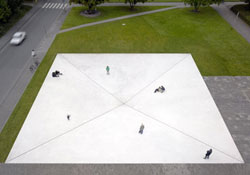 Hopping over to Kassel, Germany, the Documenta 12 worked to push boundaries through curatorial breakthroughs. Merging old with new, famous with emerging, there seemed to be no traditional order through which the Documenta was organized.
Hopping over to Kassel, Germany, the Documenta 12 worked to push boundaries through curatorial breakthroughs. Merging old with new, famous with emerging, there seemed to be no traditional order through which the Documenta was organized.
From a traditional portrait museum to temporary tent structure, viewers were repeatedly pressed to redefine what we expected from an art space, and why. As director Ruth Noack wrote, “Exhibitions are only worth looking at if we manage to dispense with preordained categories and arrive at a plateau where art communicates itself on its own terms.”
This isn’t the most comfortable way to view a large exhibition, whose works would take a full week to get through — and that’s moving quickly. The labels of works were often hidden around corners, an exercise in engaging a work of art before the predeterminations of authorship take over.
The geographic locations of artists was also withheld on labels, encouraging viewers not to categorize based on ethnicity, locale, or a city’s notoriety. The exercise was interesting in the wake of the Nationalist-driven Venice Biennale, but it made more work for viewers to have art communicate on its own terms.
Other preordained categories in the Documenta 12 were subverted in the interest of pedagogy. At the Schloss Wilhelmshöhe, a historic castle turned museum that houses a huge Dutch Master’s collection, the paintings of contemporary artist Kerry James Marshall were scattered throughout a collection of Rembrandts (shown above).
The performative aspect of this act was huge — breaking down preconceived notions of delineations in art history, integrating an artist of color into an art historical lineage self-defined by whiteness, and allowing contemporary sensibilities to play with traditional ones. But this exhibition did not succeed in its installation; it seemed happenstance, a little clumsy, and non-committal.
The desire to generate diverse conversations through the display of art was highly successful, and though its innovation wasn’t best realized in this exhibition, it offered fodder for future curatorial undertakings.
 The Skulptur Projekte Münster was last in line as a destination, and thankfully so. It proved to be a breath of fresh air in the midst of all the art going. It is an outdoor sculpture show, and by bicycle, we were able to wander the lush, green streets of Münster, equally in search of a pint of beer as the next work of art.
The Skulptur Projekte Münster was last in line as a destination, and thankfully so. It proved to be a breath of fresh air in the midst of all the art going. It is an outdoor sculpture show, and by bicycle, we were able to wander the lush, green streets of Münster, equally in search of a pint of beer as the next work of art.
It was a relief to be outside the gallery, welcoming sunshine and natural air — seemingly a reward from weeks of hard art work in temperature-controlled galleries and museums.
In a non-linear integration of past and present shows, works from Richard Serra, Donald Judd, and Rebecca Horn — who represent earlier generations in the show — could be found amidst more current invitees like Bruce Nauman, Mark Wallinger, Guy Ben-Ner and Martha Rosler.
Nauman’s work Square Depression (shown above), a project that was proposed thirty years ago, was finally made manifest this summer; it was an extraordinary and visceral work that challenged our perception of three-dimensional space.
The next Venice Biennale is scheduled for 2009; the Documenta 13 is for 2012. The next time these two shows happen in the same summer won’t be until 2017, joined again by the fifth decade of Skulptur Projekte Münster.
Given the overload of work there was to see and do, this excursion becomes a kind of work, an art-going job, in its own right. Waiting another ten years might not be so bad; after all, we need time to hibernate.
– Story by Analisa Goodin, photos (except Skulptur Projekte Münster image) by Analisa Goodin
